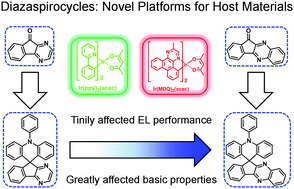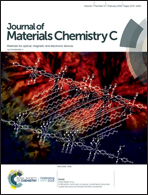Diazaspirocycles: novel platforms for efficient phosphorescent organic light-emitting diodes†
Abstract
Azafluorenone was discovered decades ago and its derivatives have received widespread attention in various research fields. However, the application of azafluorenone and its derivatives in organic light-emitting diode (OLED) materials is rarely reported and the related device performance is still not satisfactory. In this work, 1,4-diazafluorenone and its two analogues were prepared as precursors and three novel spiro compounds, SAIP, SAIQ, and SABIQ, were synthesized. The basic physical and chemical properties of SAIP, SAIQ, and SABIQ were studied in detail. From SAIP to SAIQ and SABIQ, the triplet energies (ETs) and optical band gaps (Egs) decrease gradually with the extension of the intramolecular conjugation length. In addition, blue/green/red and green/red phosphorescent OLEDs (PHOLEDs) were fabricated with SAIP and SAIQ as host materials, respectively. It is worth noting that all green and red devices based on SAIP or SAIQ showed a relatively high device performance with maximum external quantum efficiencies (EQEs) of 17.8% and 21.4%, respectively. These results further show the high potential of azafluorenone and its analogues in the building of efficient host materials.

- This article is part of the themed collection: Editor’s Choice: Spiro compounds for electronics


 Please wait while we load your content...
Please wait while we load your content...